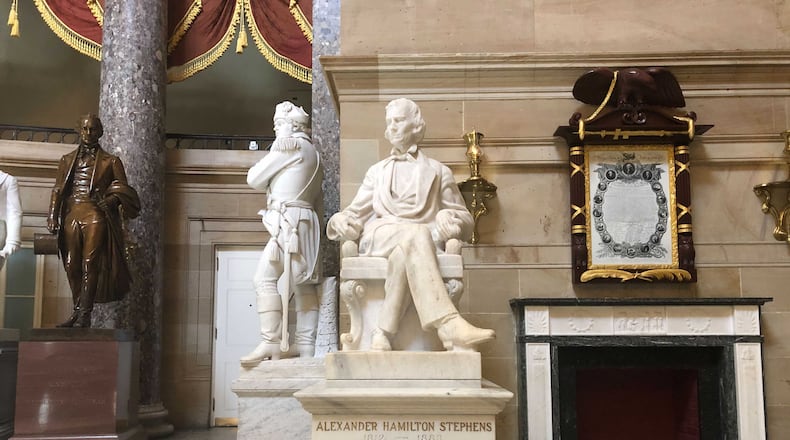When I first started work on Capitol Hill in 1980, one thing that quickly struck me as odd was all the statues on display from Southern states honoring Confederate political and military leaders.
How that came about is an interesting political tale.
157 years ago this week, on July 2, 1864, President Lincoln signed into law a plan to set up a National Statuary Hall in the Capitol, allowing each state to send two statues for display.
Those deserving of such an honor were to be ‘illustrious for their historic renown or for distinguished civic or military service’ in each state.
Supporters probably never imagined the South would then use this law to honor the Confederacy, with statues of Confederate President Jefferson Davis (1931, Mississippi), Confederate Vice President Alexander Hamilton Stephens (1927, Georgia), and several other Confederate war heroes.
It was obviously designed to send a message.
“It’s one thing to remember the nation’s Confederate traitors, it’s another thing to glorify them,” said U.S. Rep. Jamie Raskin, D-Md., as the House voted Tuesday for the second time in a year to get rid of Confederate statues on display in the Capitol.
For many years, the idea of removing Confederate statues was way too hot to handle politically — especially as Democrats watched their party evolve from one that approved those statues — into the party which wants the statues out.
At the same time, Republicans went from being the party that freed the slaves — the party of Lincoln — to the party which loudly defends symbols of the Confederacy.
Stephens has long drawn scorn for his famous speech in which the Georgian said, ‘the negro is not equal to the white man,” declaring ‘subordination to the superior race is his natural and normal condition.’
Everyone knows that message is not an attractive one for Georgia in the 21st Century.
“The legacy of Georgia must represent the best of us,” tweeted U.S. Rep. Nikema Williams, D-Atlanta. “Not the VP of the Confederacy.”
Just look at Georgia’s other U.S. Capitol statue honoring Crawford Long, described as a ‘quiet country doctor,’ who was the first to discover how ether could be used in surgery.
Certainly, there must be someone — an inventor, entrepreneur, businessman or woman, educator, musician, artist, sports hero, community leader, a decorated member of the military — someone else from Georgia’s history who could join Long in being honored.
A bipartisan bill is pending in the Georgia General Assembly to replace the Stephens statue with one of the late U.S. Rep. John Lewis. But the Legislature has not taken any action.
Just as Confederate memorials have come down in the last year amid outrage over the police killing of George Floyd, all of the Confederate statues will likely be wheeled out of the U.S. Capitol at some point.
Sooner or later, the Congress will. And it might be as soon as this year.
Jamie Dupree has covered national politics and the Congress from Washington, D.C. since the Reagan administration. His column appears weekly in The Atlanta Journal-Constitution. For more, check out his Capitol Hill newsletter at http://jamiedupree.substack.com
About the Author
Keep Reading
The Latest
Featured




